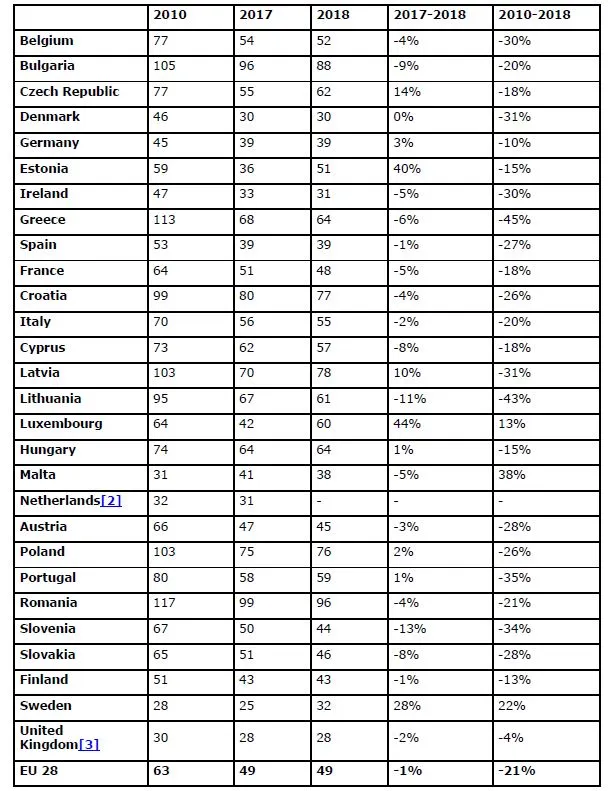Newly available data from the Insurance Institute for Highway Studies (IIHS) shows the most dangerous days for drivers on US roads. The research studied fatal crashes that occurred between 1998 and 2014, revealing that summer and early Autumn have the highest rates of fatal road crashes. The risk of crashing is higher at the weekend than during the working week, with the 3pm to 7pm time slot having a particularly high risk of road fatalities. Most dangerous of all are New Year’s Day and the US Independence
July 2, 2018
Read time: 3 mins
Newly available data from the Insurance Institute for Highway Studies (IIHS) shows the most dangerous days for drivers on US roads. The research studied fatal crashes that occurred between 1998 and 2014, revealing that summer and early Autumn have the highest rates of fatal road crashes. The risk of crashing is higher at the weekend than during the working week, with the 3pm to 7pm time slot having a particularly high risk of road fatalities. Most dangerous of all are New Year’s Day and the US Independence Day, the 4th of July.
Crashes are most common in the summer due to statistical reasons as this is when American drivers clock up the biggest distances. Data from this IIHS study back up key trend revealed in a previous analysis of road deaths that focused on the 1998-2002 period and which was published in July 2004.
The study also shows an improvement in road safety from 1998 to 2014 and with a corresponding drop in road deaths. The biggest drop in road deaths was between 2007 and 2010. Overall, an average of 106 people/day were killed in road crashes between 1998 and 2014. However there were 139 road deaths/day on average on Saturdays, compared with 89 road deaths/day on average for Tuesdays. This reveals the higher risk of fatal crashes over the weekend period. Meanwhile the 3pm to 7pm period saw most crashes, with the 3am to 6am period having the least.
The IIHS study also shows that July and August had the most fatal crashes with an average of 116/day. June, October and September had the next highest risk of fatal crashes. Despite having the poorest weather conditions, January and February had the lowest rate of crashes, reflecting the fact that drivers tend to travel shorter distances during this time period. However New Year’s Day was an anomaly for the month of January, averaging 135 deaths/day. Only US Independence day, July 4th, had a higher rate of road fatalities with an average of 140/day. These same two days also had the highest rate of fatal road crashes in the previous study.
Tougher enforcement of road rules by police officers on these two most dangerous days for drivers in the US has seen a positive benefit. The road fatality rate for US Independence Day has been cut by 13% in the period from 1998 to 2014, although the rate of road deaths for New Year’s Day has fallen by just 5%.
For vulnerable road users, different results were revealed. The data showed that pedestrian deaths were highest during late November and early December. New Year’s Day had the highest rate of pedestrian deaths. Meanwhile pedestrian deaths accounted for 12% of all road fatalities.
By comparison, motorcyclist deaths accounted for 10% of all road deaths in the US during the 1998 to 2014 period. The US Independence Day, July 4th, had the highest rate of road deaths for motorcycle riders. Overall, the summer months saw the highest rate of road deaths for motorcyclists in the US, reflecting the fact that this is when most riders take to the road network.
Crashes are most common in the summer due to statistical reasons as this is when American drivers clock up the biggest distances. Data from this IIHS study back up key trend revealed in a previous analysis of road deaths that focused on the 1998-2002 period and which was published in July 2004.
The study also shows an improvement in road safety from 1998 to 2014 and with a corresponding drop in road deaths. The biggest drop in road deaths was between 2007 and 2010. Overall, an average of 106 people/day were killed in road crashes between 1998 and 2014. However there were 139 road deaths/day on average on Saturdays, compared with 89 road deaths/day on average for Tuesdays. This reveals the higher risk of fatal crashes over the weekend period. Meanwhile the 3pm to 7pm period saw most crashes, with the 3am to 6am period having the least.
The IIHS study also shows that July and August had the most fatal crashes with an average of 116/day. June, October and September had the next highest risk of fatal crashes. Despite having the poorest weather conditions, January and February had the lowest rate of crashes, reflecting the fact that drivers tend to travel shorter distances during this time period. However New Year’s Day was an anomaly for the month of January, averaging 135 deaths/day. Only US Independence day, July 4th, had a higher rate of road fatalities with an average of 140/day. These same two days also had the highest rate of fatal road crashes in the previous study.
Tougher enforcement of road rules by police officers on these two most dangerous days for drivers in the US has seen a positive benefit. The road fatality rate for US Independence Day has been cut by 13% in the period from 1998 to 2014, although the rate of road deaths for New Year’s Day has fallen by just 5%.
For vulnerable road users, different results were revealed. The data showed that pedestrian deaths were highest during late November and early December. New Year’s Day had the highest rate of pedestrian deaths. Meanwhile pedestrian deaths accounted for 12% of all road fatalities.
By comparison, motorcyclist deaths accounted for 10% of all road deaths in the US during the 1998 to 2014 period. The US Independence Day, July 4th, had the highest rate of road deaths for motorcycle riders. Overall, the summer months saw the highest rate of road deaths for motorcyclists in the US, reflecting the fact that this is when most riders take to the road network.









